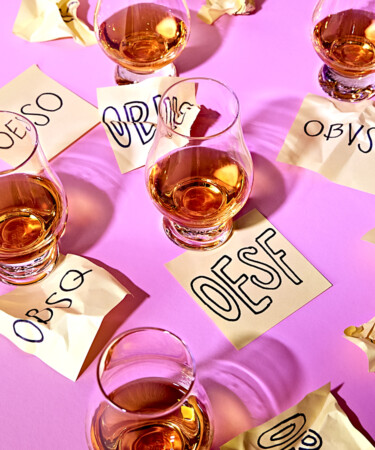Four Roses is one of the oldest and most beloved legacy bourbon distilleries in Kentucky. In many ways, the way the brand crafts its bourbon is just like every other distillery — after all, the spirit’s production is highly regulated. But Four Roses takes a completely different approach from its competitors. By using two different mash bills and five different yeast strains, the brand creates 10 different bourbons that are blended to create each of its expressions.
“Having 10 recipes allows us to stand out amongst other bourbon brands and also allows us to maintain consistency and create variety across our core line of expressions,” says master distiller Brent Elliott.
Some of the most hardcore bourbon enthusiasts have set out to taste each individual recipe. It’s a task that can be an extremely expensive and time-consuming undertaking. Before making a pilgrimage to Lawrenceburg or starting your hunt for the prized Single Barrel private selections, here’s everything you need to know about the 10 different Four Roses recipes.
Cracking the Code
Each Four Roses recipe is assigned a four-letter code that describes how it’s made. The first letter of every code is always “O.” This refers to the fact that it was made at Four Roses Distillery. So if this code references that the whiskey was distilled at Four Roses, why is it represented with an “O”? “[Four Roses] was originally called ‘Old Prentice’ distillery when it was built in 1910,” Elliott explains.
The second is either “B” or “E.” “It designates which mash bill is used and therefore indicates the ratio of corn, rye, and malted barley,” Elliott says. Mash bill “B” is the high-rye mash bill made up of 60 percent corn, 35 percent rye, and 5 percent malted barley and tends to impart more spice to the finished bourbon. The low-rye mash bill is “E” and consists of 75 percent corn, 20 percent rye, and 5 percent malted barley and produces a rounder, softer flavor profile.
Just like the first letter in the code, the third is always “S.” It simply means that each recipe is a straight bourbon whiskey.
The final letter in the recipe code refers to which of the five yeast strains is used in each recipe. The different strains all impart a slightly different flavor to each recipe during the fermentation process. Each is denoted with the letters “V,” which, according to the distiller, gives notes of delicate fruit: “K” with slight spice, “O” with rich fruit flavors, “Q” a floral essence, and “F,” which imparts minty, herbal notes.
Tasting Each Recipe
Given that each is still made by Four Roses, there are some overarching similarities in flavor across the entire spectrum. But the different permutations of mash bill and yeast strain give each recipe a subtly unique aroma and taste. Here’s what you can expect from each recipe.
- OBSV: Rye-forward, with delicate notes of pear, apple, and vanilla and spice on the finish.
- OBSK: Baking spice aroma with sweet vanilla and cherry on the palate. Very spice-forward overall.
- OBSO: Rich red fruit aromas translate to the palate with the addition of oak and rye spice notes.
- OBSQ: Overall very floral, light, and berry-forward.
- OBSF: Full-flavored and viscous with prominent notes of mint, spice, and berry.
- OESV: Round and sweet with notes of caramel, stone fruit, and pear.
- OESK: Lots of spice and vanilla on the nose. Rounded palate with nutmeg, cinnamon, cherry, and brown sugar.
- OESO: Ripe red apple, with maraschino cherry, toffee, and stone fruit. Very rich and viscous.
- OESQ: Floral aromas of cherry blossom. Delicate fruit notes balanced with spice and honey on the palate.
- OESF: Mint, toffee, and honey on the nose and palate with a touch of oak and spice.
Blending the Recipes
Each of the bourbons that Four Roses produces uses a different blend of recipes to reach the distillery’s desired flavor profile. The recipes may be aged for different lengths of time, but the same combination of recipes goes into each individual bottle.
Four Roses Bourbon: The flagship bottle in the Four Roses portfolio consists of a blend of all 10 recipes and is aged for a minimum of five years.
Four Roses Small Batch: This bourbon is a blend of four recipes: OBSK, OBSO, OESK, and OESO. “The result is a palate of ripened red berries and dried spice, a nose of rich fruits with hints of sweet oak and caramel,” Elliott says. Four Roses Small Batch is aged for six to seven years.
Four Roses Small Batch Select: Small Batch Select is Four Roses’ non-chill-filtered, 104-proof expression. This bourbon is aged for six to seven years and uses six recipes: OBSV, OBSK, OBSF, OESV, OESK, and OESF.
Four Roses Single Barrel: As the name implies, Four Roses Single Barrel is not blended and therefore uses just one recipe. In this case, every bottle of the 100-proof Single Barrel is a seven- to nine-year-old OBSV.
Four Roses Single Barrel Barrel Strength: Each of these barrel-proof single barrel bottles can come from any one of the 10 Four Roses recipes. Until the release of the 10 Recipe Tasting Experience this year, the only way enthusiasts could taste each recipe was by finding bottles of these eight- to 10-year-old single barrels as private store selections.
Four Roses Small Batch Limited Edition: Each year, Four Roses releases a limited-edition Small Batch Bourbon made with a unique combination of different recipes matured to a different degree. The 2023 release marks the 135th Anniversary Limited Edition Small Batch bourbon. “To create this limited bottling we used a 12-year-old and a 16-year-old OESV recipe, which features notes of delicate fruit and caramel; a 14- year-old OESK recipe, with notes of baking spice; and a 25-year-old OBSV recipe that boasts delicate fruit and rye flavors,” Elliot explains. But every year’s Limited Edition bottling is different.
